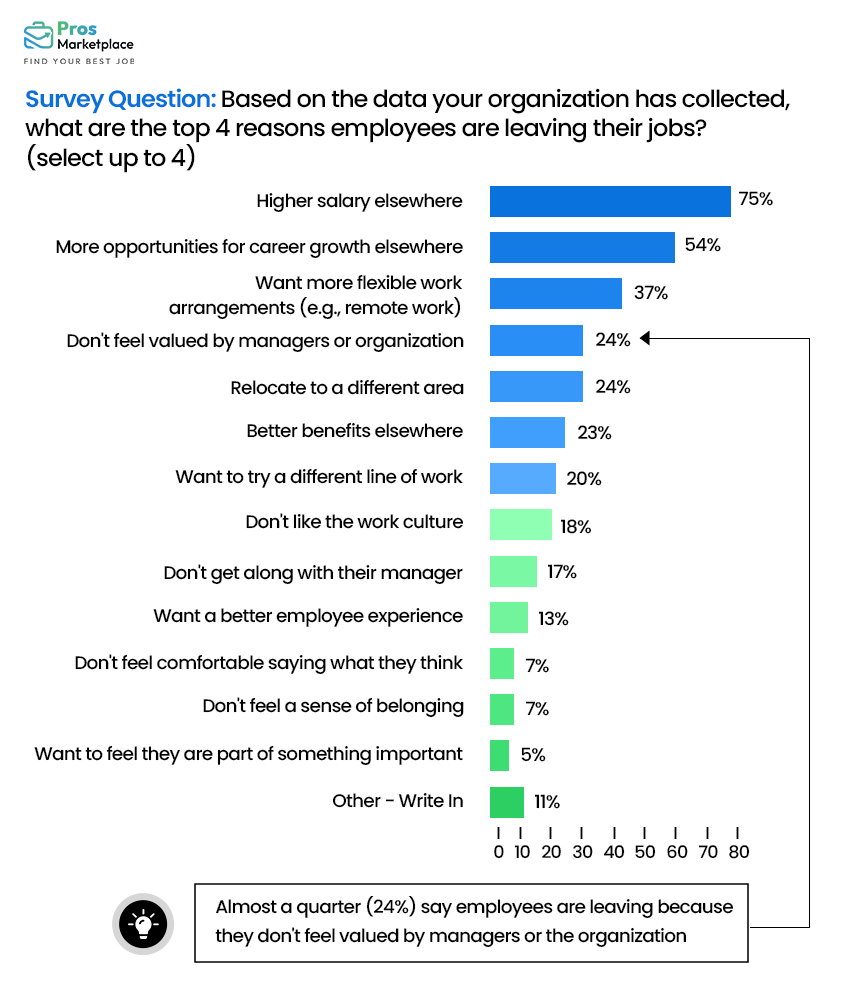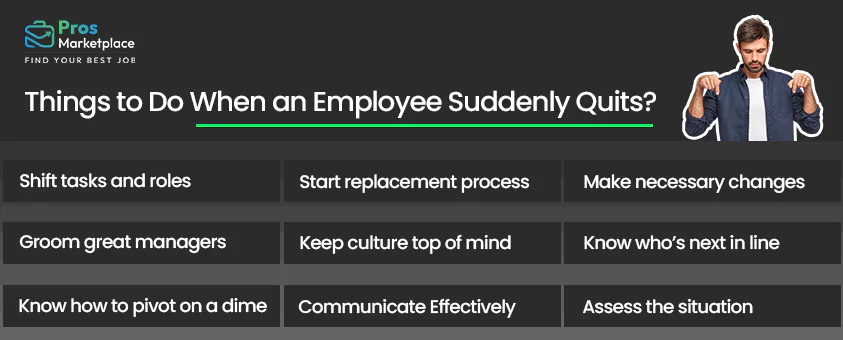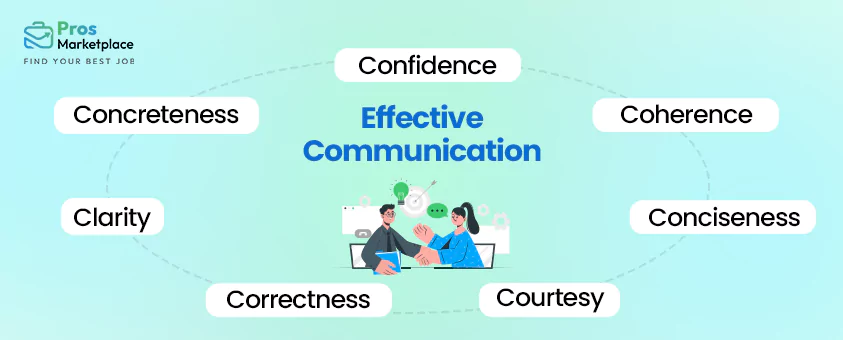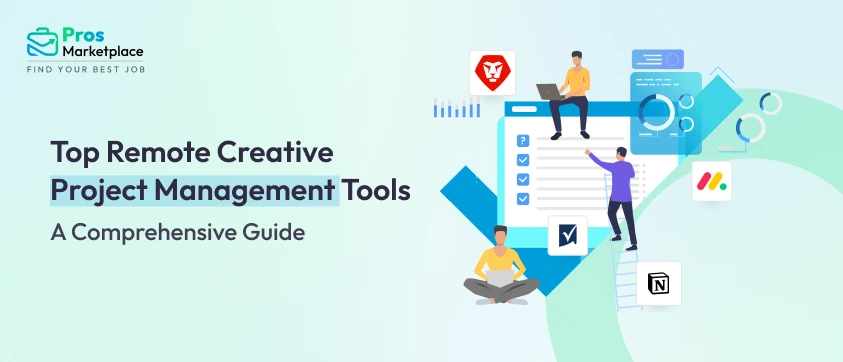An organization’s performance usually depends on its employees. Their roles and positions, play a major role in affecting their position in the market.
That is why when an employee quits without notice it affects the work processes. Although the operations continue, a quick decision to take it forward becomes necessary. These situations demand an approach to perform accurately to take the work processes forward amidst the chaos.
When an employee suddenly quits without prior notice the inability of the organization to fully ensure the effectiveness of every personnel decision can lead to work disruptions.
The problem of shifts in responsibilities and other concerns like work culture often become evident.
Dealing with things when an employee leaves suddenly can be tough for employers, especially if you are a start-up. But handling it right can make all the difference. Let’s explore some smart ways to manage the situation when you are wondering what to do when an employee suddenly quits and to keep things running smoothly.
Understanding Why Employees Leave

Source: hr.com
People leave their jobs for all sorts of reasons. Some personal things, like moving or family needs, are beyond a company’s control. But there are work-related issues too, like how they feel about the job or if they see opportunities to grow. Understanding the reasons can help your company continue to work flawlessly when an employee suddenly quits. Here is what you can do:
- Check Things Out: Talk to the person leaving instead of panicking. Find out why they’re going and what they think about their time at the company. Their feedback can help make things better in the future.
- Follow the Rules: Do everything by the book. Pay them what’s owed, handle benefits right, and stick to any notice periods.
- Plan: Have a backup plan on who’s going to do what now that someone’s leaving. Maybe others can take on their tasks, or you might need to hire someone new. Planning and training can keep things going smoothly.
- Keep Talking: Let the team know what’s happening and how things might change. Being honest and clear can help everyone feel better about what’s going on.
- Taking Smart Steps: When someone quits out of the blue, it’s important to stay calm and figure things out. Here’s what can help:
Also Read: How to Manage a Remote Team?
Turning Departures into Opportunities
Departures in the workplace can look like disruptions to the established workflow and team dynamics. However, they also present unique opportunities for growth and transformation.
Recognizing the potential in these departures offers a chance to reassess team structures, identify emerging leaders, and redistribute responsibilities to maximize efficiency and productivity. Collaboration among remaining team members is essential during such transitions, as it encourages knowledge sharing and strengthens bonds within the team.
When someone leaves, it’s a chance for the company to learn and grow with:
Exit Chats: Talking to people who leave can give valuable insights. Find out what they liked and didn’t like about working there. This info can help make things better for others.
Building a Great Work Environment: Making the workplace welcoming and supportive can keep people around. Good communication, feedback, and chances to learn and grow make a big difference.
Always Improving: Use what’s learned from departures to make things better. Fix any problems, like bad management or communication issues. Making the workplace better keeps everyone happy.

Best Strategies For Handling Sudden Employee Resignations Effectively
No business owner or manager wants to think key employees leave due to their management style or workplace culture. But sometimes this becomes the truth. In a situation like this, evaluate whether these issues impact your team.
Begin shifting tasks and roles
Before the employee leaves, ask them to document their day-to-day activities, duties, and the status of any outstanding projects. Ask them to list all the resources their replacement will need to continue the work. This detailed information will help you fill the gap when you are wondering what to do when an employee suddenly resigns.
This is also a good time to evaluate whether you should backfill the role as is or make changes to it. Do you need to backfill the role at all? How important is the work compared to other priorities? Can the work be distributed to other team members without overloading them?
Begin the process of replacement
If you decide that your business would benefit from backfilling the role, make sure your next hire is someone who is a good fit, both from a skills and a company culture standpoint. Consider shifting parts of the departing employee’s workload to independent talent while you search for a new hire.
However, it’s important to manage communication about the changes. While it is important not to go into too much detail about why the employee left, you may decide to provide enough information to the people who worked directly with them so that they understand what duties might fall to them. Being proactive is also important. So, provide essential information so that current team members aren’t left to guess and fill in the blanks themselves.
Communicate Effectively

Transparent communication is essential to maintain trust and morale among remaining employees. Keep the team informed about the departure and any changes in responsibilities or workflows. Address concerns and provide reassurance to alleviate uncertainty.
Make necessary changes within the company
A sudden employee departure can bring new insights that make your company stronger. Learn from the employee’s exit interview and make changes to improve the overall work environment.
Look at the pain points that resulted from the team member’s resignation and seek ways to avoid future workplace upheaval. For instance:
Groom great managers
A good place to begin is by assessing how employees perceive their managers. Look for factors that could contribute to attrition – maybe managers aren’t giving enough feedback or recognition or are micromanaging their team. Introduce new management methods and training to help stave off future problems.
Keep culture top of mind
This means keeping your finger on the pulse of how employees are feeling through check-ins and surveys. Don’t wait to survey until right after an employee leaves; make it a normal part of the work process. A leader who treats their team with respect will almost always receive respect back. That will make all the difference when dealing with the inevitable transitions and upheavals that every company confronts.
Know who’s next in line
Sometimes, an employee resignation is unavoidable. That’s why it’s important to consider succession planning. Ideally, if someone leaves, another person on the team should be able to step in and help. Do you have someone next in line if the role is suddenly empty? This also includes your role!
Know how to save costs
Don’t leave yourself open to costly project delays or unhappy clients when personnel changes occur. Build a virtual talent bench of freelance professionals from marketplaces like Pros Marketplace to search for workers whenever you need an extra hand.
Assess the situation
You might be startled initially at the employee’s sudden resignation. Your knee-jerk response, especially if you run a smaller company that will feel an immediate fallout from the work disruption might be to panic. You might even take the resignation personally and think, “How could they do this to me?
While these types of feelings are perfectly natural, keep them to yourself.
Conclusion
What to do when an employee suddenly resigns is a question that often makes things difficult for employers. Organizations can minimize the damage caused by departures, transform the remaining team members’ collaboration, and benefit from the departures if they embrace flexibility. Accepting change as a normal part of the professional development process lets employers develop employees who are adaptable to work well regardless of volatile situations. Eventually, by looking at departures as an opportunity, not an obstacle, managers can create an environment where no one is afraid of transformation and progress.







